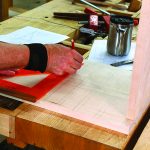We may receive a commission when you use our affiliate links. However, this does not impact our recommendations.
 Yesterday, after reading Christopher Schwarz’s blog entry about beginning an apprenticeship with his 10-year-old daughter, I was prompted to think about two things; the panel discussion that we have scheduled at Woodworking in America this year titled, “How to Save Woodworking – Five views” and the film “Pay it Forward” that came out in 2000, which was adapted from Catherine Ryan Hyde’s novel by the same name.
Yesterday, after reading Christopher Schwarz’s blog entry about beginning an apprenticeship with his 10-year-old daughter, I was prompted to think about two things; the panel discussion that we have scheduled at Woodworking in America this year titled, “How to Save Woodworking – Five views” and the film “Pay it Forward” that came out in 2000, which was adapted from Catherine Ryan Hyde’s novel by the same name.
In the movie, a young boy is given an extra-credit assignment by his teacher to think of an idea to change our world – and put it into action. The boy comes up with the idea that we could save the world if everyone did three good deeds for others in repayment of a good deed that they received. Such good deeds should be things that the other person cannot accomplish on their own. In this way, the need to help one another can spread exponentially through society.
The concept is not a new one. It was first used in a play by the Greek dramatist Menander, in a play “Dyskolos” (translated as “The Grouch”), which was a prizewinning play in ancient Athens in 317 BCE. The concept was rediscovered and described by Benjamin Franklin, in a letter to Benjamin Webb, dated April 22, 1784:
“I do not pretend to give such a Sum; I only lend it to you. When you […] meet with another honest Man in similar Distress, you must pay me by lending this Sum to him; enjoining him to discharge the Debt by a like operation, when he shall be able, and shall meet with another opportunity. I hope it may thus go thro’ many hands, before it meets with a Knave that will stop its Progress. This is a trick of mine for doing a deal of good with a little money.”
So, just as Chris is doing his part with his daughter, it is up to everyone of us to find a young person or three and pass on our craft with the understanding that they must, in turn, find their own apprentices. What better gift could you give a someone? Essentially, you’ll be giving them a gift that will last a lifetime and resonate through countless others.
If you want to see a clip from the film, Pay it Forward, click here.
Check out these woodworking books for children at ShopWoodworking.com.
Here are some supplies and tools we find essential in our everyday work around the shop. We may receive a commission from sales referred by our links; however, we have carefully selected these products for their usefulness and quality.









This is something I’ve wanted to do, but have been hesitant thus far. The problem? A litigious society. I think I could mentor a young person in an unplugged shop, but I wouldn’t be comfortable teaching in my hybrid situation. It is sad when a society effectively squashes this type of learning possibilities.
My young neighbor has asked for help a couple of times. I think a friendly lesson or two in Woodworking can’t hurt, and see where it goes from there.
The craft of woodworking is too important and too much fun to let die.
Thanks.
Is this some kind of pyramid scheme? 🙂
Several of the wood working schools (for chronological Adults) have started to act somewhat on this concept. Parent/Child (or Junior/Senior) wood working classes are offered.
I have taken my nephew to a couple a year for the past 3 years, he is 12 now. Making spinning tops on the lathe is one of his favorite projects, work with the scroll saw and this year we made Shaker boxes. His interest has been peaked and he comes to my shop about once a month now to make something.
With the loss of the guild/apprentice system in the US – the only way to preserve the craft is to pull the kids away from their video games and find something that will interest them in the shop.
MASW offers several classes a year that kids with an accompanying adult can take – Turning with Alan Lacer, Whirligigs, skateboard making, Shaker box and a cool little class called “pick’in Stick” this fall.